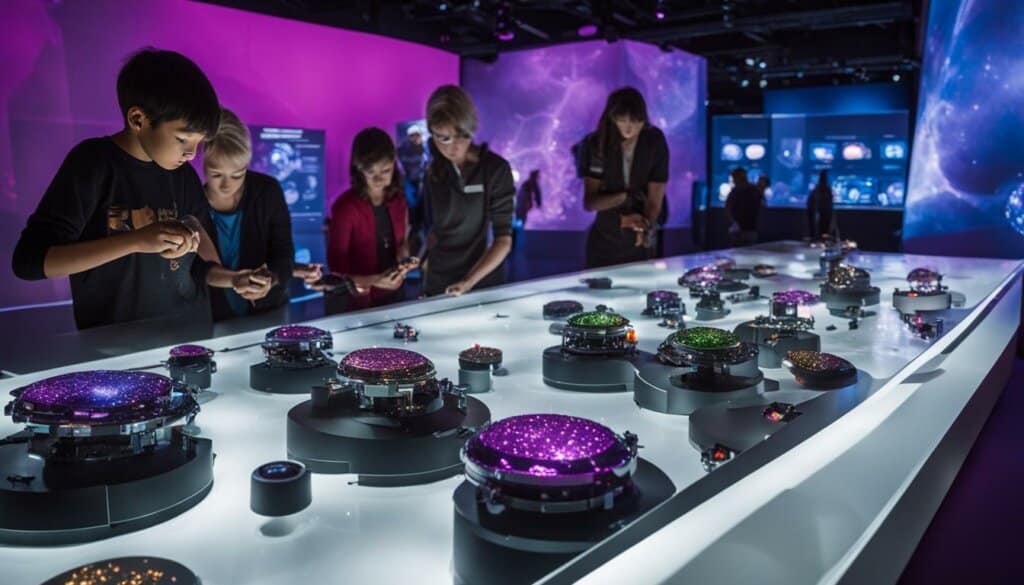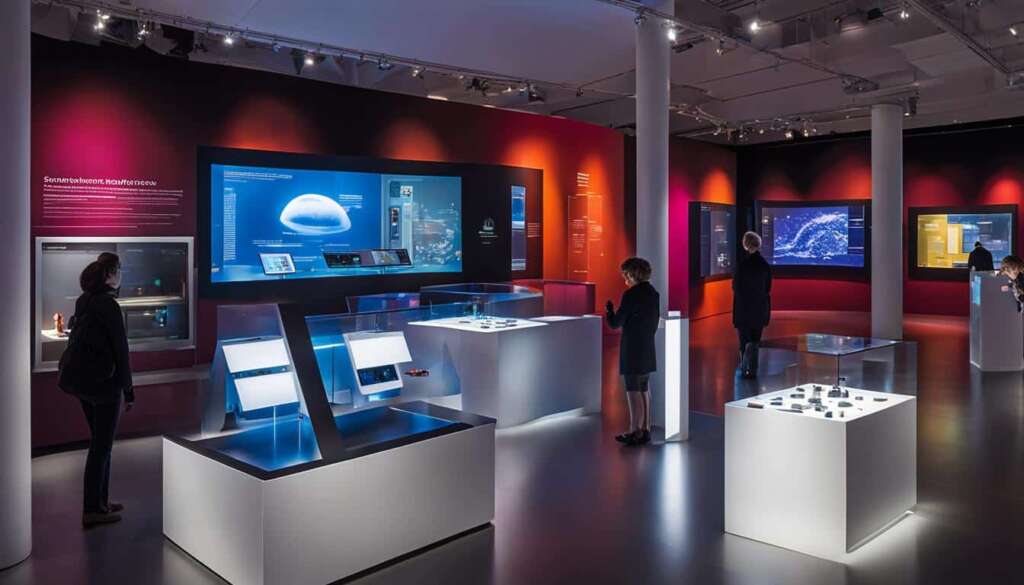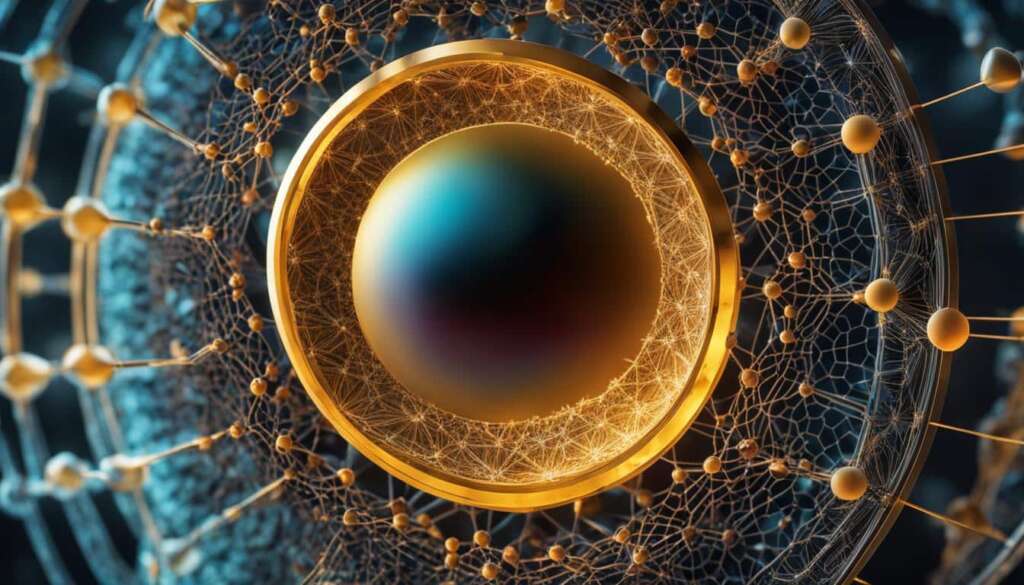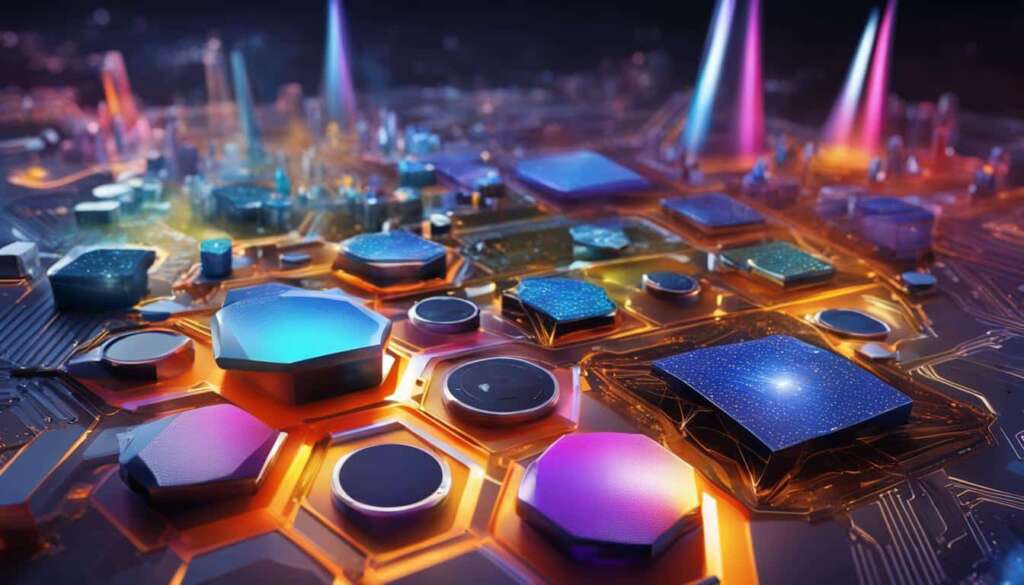Table of Contents
The Lafayette Science Museum offers an interactive exhibition called Nano, which explores the world of nanoscale science, engineering, and technology. Visitors can learn about the basics of nanoscience and engineering, discover real-world applications of nanotechnology, and explore the societal and ethical implications of this emerging field. Nanotechnology allows us to build things atom by atom, resulting in unique properties and behaviours at the nanometre scale.
Key Takeaways:
- The Lafayette Science Museum offers an interactive exhibition called Nano
- Visitors can learn about the basics of nanoscience and engineering
- Discover real-world applications of nanotechnology
- Explore the societal and ethical implications of nanotechnology
- Nanotechnology allows us to build things atom by atom
What is Nanoscience and Engineering?
Nanoscience is the study of structures and materials on the scale of nanometers, where one nanometer is one billionth of a meter. At this scale, materials can exhibit unexpected properties and behaviors. Nanotechnology employs nanoscale science and engineering to design and create innovative products and technologies. By manipulating atoms and molecules, scientists and engineers can develop materials with enhanced properties and explore new avenues for technological advancement.
Properties and Behaviors at the Nanoscale
The nanoscale, with its unique characteristics, offers exciting possibilities for the field of nanoscience. When materials are reduced to nanoscale dimensions, their physical, chemical, and biological properties can change significantly. For example, gold nanoparticles exhibit different colors depending on their size, quantum dots can emit light of specific colors, and carbon nanotubes possess extraordinary strength and electrical conductivity. These exceptional properties hold immense promise for a wide range of applications.
Materials at the nanoscale can be engineered to exhibit properties not observed in larger-scale materials, making nanotechnology a burgeoning field of research and development.
Nanotechnology and Innovation
Nanotechnology harnesses the potential of nanoscale science and engineering to revolutionize various industries. By manipulating and fabricating materials at the atomic and molecular levels, scientists and engineers can create novel structures with tailored properties. The engineering of nanoparticles, nanocomposites, and nanodevices has led to advancements in electronics, medicine, energy, and many other fields. Nanotechnology not only offers opportunities for innovation but also challenges us to explore the ethical and societal implications of these advancements.
The Intersection of Science and Engineering
Nanoscience and engineering go hand in hand to drive advancements in nanotechnology. Nanoscientists strive to understand the fundamental principles and behaviors of materials at the nanoscale, while engineers apply this knowledge to design and develop practical applications. The synergy between these disciplines allows for the creation of cutting-edge technologies that push the boundaries of what is possible. Examples include nanoparticle-based drug delivery systems, self-healing materials, and nanosensors for environmental monitoring.
| Nanoscience | Nanotechnology | Engineering |
|---|---|---|
| Study of structures and materials at the nanoscale | Application of nanoscale science and engineering | Utilizes nanoscience to design and create innovative products and technologies |
| Analyzes the properties and behaviors of nanomaterials | Explores real-world applications and their societal implications | Manipulates atoms and molecules to develop materials with enhanced properties |
| Investigates the intersection of physics, chemistry, and biology at the nanoscale | Focuses on developing nanoscale devices and systems | Applies scientific knowledge to practical engineering solutions |
As nanoscience and engineering continue to advance, the potential for groundbreaking discoveries and technological innovations grows. By unlocking the secrets of the nanoscale world, scientists and engineers are opening doors to a future where nanotechnology plays a transformative role in our everyday lives.
The Implications of Nanotechnology
As nanotechnology continues to advance, it is important to consider the societal and ethical implications. The ability to manipulate matter at the atomic and molecular level brings both benefits and challenges. Nanotechnology has the potential to revolutionize various industries, from medicine and electronics to energy and manufacturing. However, it also raises concerns regarding the safety and environmental impact of nanomaterials, as well as potential ethical dilemmas associated with their use.
Societal Implications
Nanotechnology has the power to transform society by enabling the development of advanced medical treatments, more efficient energy solutions, and revolutionary manufacturing processes. For instance, in medicine, nanotechnology offers the potential for targeted drug delivery, early disease detection, and personalized treatments. In the manufacturing sector, nanomaterials can enhance product performance and durability, leading to more sustainable and eco-friendly products. Additionally, nanotechnology has applications in electronics, creating smaller, faster, and more energy-efficient devices.
However, societal implications arise as nanotechnology becomes integrated into various aspects of our lives. Issues such as access, affordability, and potential inequalities must be addressed to ensure that the benefits of nanotechnology are accessible to all members of society. Additionally, the potential displacement of certain industries and the need for new skills and workforce training should be considered to mitigate any negative societal impacts.
Ethical Implications
Nanotechnology presents ethical considerations that must be carefully examined. The ability to engineer materials at the nanoscale raises questions about the responsible use of technology and the potential risks associated with nanotechnology. Ensuring the safety of nanomaterials, both during their production and use, is crucial to protect human health and the environment.
Furthermore, the ethical implications of nanotechnology involve privacy concerns, potential unintended consequences, and the equitable distribution of benefits and risks. For example, nanosensors could enable pervasive monitoring, raising concerns about personal privacy and surveillance. Additionally, the long-term effects of nanomaterials on ecosystems and the environment need to be thoroughly studied to ensure sustainable and responsible development.
“Nanotechnology holds immense potential for societal advancements, but it is our responsibility to navigate the ethical considerations and ensure its safe and equitable adoption.”
| Societal Implications | Ethical Implications |
|---|---|
| Revolutionize industries such as medicine, electronics, energy, and manufacturing. | Responsible use of technology to protect human health and the environment. |
| Access, affordability, and potential inequalities in the benefits of nanotechnology. | Privacy concerns and potential unintended consequences. |
| Potential job displacement and the need for new skills and workforce training. | Equitable distribution of benefits and risks. |
Nanotechnology presents immense opportunities for societal advancements, but it also requires careful navigation of the ethical considerations to ensure safe and equitable adoption. By addressing the societal and ethical implications, we can foster a responsible and sustainable nanotechnology revolution.
Exploring Nano at the Science Museum
The Gateway Science Museum offers an immersive exhibition called “Zoom Into Nano.” This interactive exhibit allows visitors to explore the world of nanotechnology through hands-on experiences. Visitors can view enlarged models of atoms and molecules, learn how scientists create at the nanoscale, and even detect invisible molecules using their sense of smell. The exhibit aims to engage and inspire visitors to appreciate the wonders of nanoscience and understand its potential impact on our lives.

This exhibit presents a unique opportunity for visitors to have a truly interactive and educational experience. By engaging with hands-on exhibits and participating in various activities, visitors can gain a deeper understanding of nanotechnology and its applications in the real world. The “Zoom Into Nano” exhibit is designed to cater to visitors of all ages, making it a perfect destination for families, school groups, and science enthusiasts alike.
A Hands-On Exploration of Nanotechnology
Through the interactive exhibit, visitors can actively explore the world of nanotechnology. They can manipulate nanoscale materials, observe the behavior of atoms and molecules, and discover the properties that make nanotechnology so fascinating. The exhibit provides a comprehensive overview of nanoscience and engineering, highlighting its impact on various fields, including medicine, electronics, and energy.
Engaging Activities and Demonstrations
The interactive nature of the exhibit allows visitors to engage with nanotechnology in a meaningful way. They can participate in activities like building molecular models, investigating the unique characteristics of nanomaterials, and learning about the cutting-edge research happening in the field. Additionally, the exhibit features demonstrations that showcase the practical applications of nanotechnology, further emphasizing its relevance in our everyday lives.
Real-World Applications and Implications
One of the highlights of the “Zoom Into Nano” exhibit is the exploration of real-world applications and the societal impact of nanotechnology. Visitors can learn how nanotechnology is being used to develop advanced medical treatments, create energy-efficient materials, and revolutionize electronics. The exhibit also delves into the ethical considerations surrounding nanotechnology, sparking discussions on responsible innovation and the potential risks associated with its widespread adoption.
An Educational and Inspiring Experience
The “Zoom Into Nano” exhibit at the Gateway Science Museum offers a unique blend of education and inspiration. By providing visitors with a hands-on and immersive experience, the exhibit aims to ignite a passion for science and technology. Through interactive displays, engaging activities, and thought-provoking discussions, visitors can deepen their understanding of nanotechnology and its role in shaping our future.
| Key Features of “Zoom Into Nano” Exhibit | Benefits for Visitors |
|---|---|
| Hands-on experiences | Active engagement and deeper understanding |
| Real-world applications | Inspiration and awareness of nanotechnology’s impact |
| Societal and ethical implications | Stimulated discussions and critical thinking |
| Interactive displays and demonstrations | Memorable and enjoyable learning experience |
Scientific Advances in Nanotechnology
Nanotechnology, with its remarkable scientific advances, is revolutionizing various industries and paving the way for innovative applications in medicine, electronics, energy, and materials science. This section explores some of the groundbreaking nanotechnology applications that researchers are currently developing and highlights the potential future goals for this exciting field of study.
Targeted Drug Delivery Systems
One of the most promising applications of nanotechnology in medicine is the development of targeted drug delivery systems. These systems utilize nanoscale carriers, such as nanoparticles or liposomes, to deliver medications directly to diseased cells or tissues. By encapsulating drugs within these nanocarriers, scientists can enhance drug stability, prolong circulation time, and achieve controlled release, ensuring optimal therapeutic outcomes with reduced side effects.
Nanosensors for Early Disease Detection
Nanotechnology also holds great potential for early disease detection through the development of nanosensors. These tiny, sensitive devices can detect specific biomarkers or abnormal cellular activities associated with diseases, enabling early diagnosis and intervention. Nanosensors can be engineered to detect a wide range of conditions, including cancer, infectious diseases, and neurodegenerative disorders, enhancing the chances of successful treatment and improving patient outcomes.
Enhanced Performance of Electronics
Advancements in nanotechnology have led to the development of nanoscale electronic components that possess superior properties compared to their traditional counterparts. Nanomaterials, such as carbon nanotubes and graphene, exhibit remarkable electrical conductivity, thermal conductivity, and mechanical strength, making them ideal candidates for the development of high-performance electronics. These nanoelectronics offer benefits such as faster processing speeds, reduced power consumption, and enhanced device miniaturization.
More Efficient Energy Storage Devices
Another exciting application of nanotechnology is in the field of energy storage. Nanomaterials, such as nanowires and nanopores, can significantly improve the performance and efficiency of batteries and supercapacitors. By increasing the surface area available for electrochemical reactions, nanomaterial-based energy storage devices provide higher energy densities, faster charging rates, and longer cycle lifetimes. These advancements are vital for the development of sustainable energy solutions, such as electric vehicles and renewable energy storage systems.
New Materials with Superior Properties
Nanotechnology enables the creation of new materials with unique properties and functionalities that cannot be achieved with conventional manufacturing techniques. By manipulating matter at the nanoscale, scientists can tailor the composition, structure, and surface properties of materials to achieve desired characteristics. For example, nanocomposites combining different types of nanoparticles with a matrix material can exhibit enhanced mechanical strength, improved thermal stability, and superior electrical conductivity, opening up possibilities for the development of advanced materials in industries ranging from aerospace to construction.
The scientific advances in nanotechnology showcased in this section demonstrate the immense potential of this field. From targeted drug delivery systems to nanosensors for early disease detection, nanotechnology has the power to revolutionize industries, improve healthcare outcomes, and create sustainable energy solutions. As researchers continue to make new discoveries and push the boundaries of nanoscale science, the applications and impact of nanotechnology will only continue to grow.
Nano Exhibition for Family Audiences
The Nano exhibition, developed as part of the Nanoscale Informal Science Education Network (NISE Net), aims to engage family audiences in nanoscale science and technology. This interactive exhibition presents the basics of nanoscience and engineering, showcases real-world applications, and explores the societal and ethical implications of nanotechnology.
The exhibition has been distributed to museums across the United States, reaching tens of millions of people. It serves as an educational resource for both museum visitors and participants of NanoDays events. Families visiting the exhibition will have the opportunity to learn about the fascinating world of nanotechnology through hands-on activities and immersive displays.
The Nano exhibition is designed to spark curiosity and inspire young minds. By providing a comprehensive overview of nanoscience and its applications, the exhibition aims to promote scientific literacy among family audiences. Visitors can explore the properties of nanomaterials, learn about the latest advances in nanotechnology, and gain a deeper understanding of its impact on various industries.
Throughout the exhibition, families will have the chance to participate in interactive experiments, manipulate nanoscale objects, and discover how nanotechnology is transforming the world around us. The exhibition also addresses the societal and ethical implications of nanotechnology, encouraging dialogue and critical thinking.
“The Nano exhibition offers a unique opportunity for families to explore the world of nanoscale science and technology together. Through its engaging and interactive displays, the exhibition sparks curiosity and fosters a deeper understanding of this emerging field.”
In addition to the exhibition itself, the Nanoscale Informal Science Education Network (NISE Net) provides resources and educational materials for families to continue their exploration of nanoscience at home. These resources include DIY nanoscience experiments, online activities, and suggested reading materials for further exploration.
Key Features of the Nano Exhibition:
- Engaging hands-on activities
- Interactive displays and experiments
- Real-world examples of nanotechnology applications
- Exploration of societal and ethical implications
| Exhibition Features | Description |
|---|---|
| Hands-on Activities | Visitors can participate in interactive experiments that demonstrate the principles of nanoscience and engineering. |
| Interactive Displays | Immersive exhibits allow families to explore nanoscale objects and learn about their unique properties. |
| Real-world Applications | The exhibition showcases the diverse range of nanotechnology applications in industries such as medicine, electronics, and energy. |
| Societal and Ethical Implications | Families can discuss and reflect on the societal and ethical considerations surrounding nanotechnology. |
The Impact of Nanoscale Research and Education
The Nanoscale Informal Science Education Network (NISE Net), funded by the National Science Foundation, plays a vital role in fostering public awareness and understanding of nanoscale science, engineering, and technology. NISE Net aims to engage audiences in STEM topics, including nanotechnology, through a range of educational programs, formative and summative evaluation, research on visitor learning, and online resources.
Working in collaboration with leading institutions such as the Science Museum of Minnesota, the Museum of Science, and Arizona State University, NISE Net has established a national community of researchers and informal science educators. By connecting experts in the field, NISE Net promotes the exchange of knowledge and best practices, ultimately enhancing the quality of science education and outreach efforts.
The network’s emphasis on nanoscale research and education is critical in preparing future generations to navigate the rapidly advancing world of science and technology. Through engaging and interactive experiences, NISE Net strives to inspire curiosity, spark interest, and cultivate a lifelong passion for scientific exploration among learners of all ages.

The image above visually represents the innovative research and education initiatives led by NISE Net. It symbolizes the dynamic nature of nanoscience and the impact it has on shaping our understanding of the world at the atomic and molecular level.
Engaging with Nanotechnology at the Science Museum
The Gateway Science Museum offers the Museum Without Walls (MWOW) lecture series, which complements the “Zoom Into Nano” exhibit. The lecture series features presentations by California State University, Chico faculty and covers various topics related to nanotechnology. In addition, the museum extends its opening hours on select Thursdays to provide visitors with more time to engage with the world of nanotechnology. These initiatives aim to create a comprehensive and immersive experience for visitors, combining hands-on exploration with educational lectures and extended access.
Visitors to the Gateway Science Museum have the opportunity to delve deeper into the realm of nanotechnology through the Museum Without Walls (MWOW) lecture series. This captivating series features presentations by esteemed faculty from California State University, Chico, where guests can learn about the latest advancements and discoveries in the field of nanotechnology. Covering a range of topics related to nanoscience and engineering, these informative lectures offer valuable insights and stimulate thought-provoking discussions.
Adding to the immersive experience, the museum extends its opening hours on select Thursdays, allowing visitors to fully engage with the “Zoom Into Nano” exhibit and delve into the fascinating world of nanotechnology. With extended access, guests can take their time exploring the hands-on exhibits, examining the intricate models of atoms and molecules, and discovering the wonders of nanoscale science and engineering.
The Museum Without Walls (MWOW) lecture series and extended opening hours are part of the museum’s commitment to visitor engagement and education. By combining interactive exploration with informative lectures, the Gateway Science Museum aims to create a comprehensive experience that caters to diverse interests and learning styles.
Whether you’re a science enthusiast, a student, or simply curious about the world of nanotechnology, the Gateway Science Museum provides a platform for engaging with this cutting-edge field. Experience the thrill of discovery and delve into the limitless possibilities of nanoscience and engineering.
Plan Your Visit to the Science Museum
If you’re excited to explore the world of nanotechnology at the Gateway Science Museum, here’s what you need to know before your visit. Located at 625 Esplanade, the museum offers a range of exhibits, including the captivating “Zoom Into Nano” exhibit.
Admission to the museum is $7 for adults, $5 for children and students, and free for museum members. This affordable pricing allows visitors of all ages to experience the wonders of nanoscale science, engineering, and technology.
The museum is open Wednesday through Sunday, from noon to 5 p.m. These convenient hours give you plenty of time to immerse yourself in the interactive exhibits, hands-on activities, and educational programs available at the Gateway Science Museum.
For more information about admission, exhibits, and special events, you can contact the museum by calling 530-898-5130. Alternatively, you can visit the museum’s website at www.csuchico.edu/gateway to explore their offerings and plan your visit in advance.
Make the most of your experience at the Gateway Science Museum and discover the fascinating world of nanotechnology!

Conclusion
Exploring the field of nanotechnology at the science museum provides visitors with a unique opportunity to delve into the world of nanoscale science, engineering, and technology. Through interactive exhibits, hands-on experiences, and educational programs, visitors can gain a deeper understanding of the impact of nanotechnology on various industries and our society as a whole.
The museum aims to inspire curiosity, spark fascination, and promote scientific literacy among visitors of all ages.
| Nanotechnology Exhibition Highlights | Visitor Benefits |
|---|---|
| Interactive exhibits and hands-on experiences | Engage and entertain visitors while fostering a deeper understanding of nanotechnology |
| Educational programs and lectures | Enrich visitors’ knowledge and provide valuable insights into the world of nanoscale science and engineering |
| Showcasing real-world applications | Illustrate how nanotechnology is transforming various industries, from medicine to electronics |
| Exploration of societal and ethical implications | Promote discussions and critical thinking about the responsible use of nanotechnology |
Whether you’re a science enthusiast, a student, or a curious visitor, a science museum experience focused on nanotechnology exploration offers a captivating and educational journey into the cutting-edge world of nanoscale science. Don’t miss the opportunity to witness the wonders of nanotechnology at your nearest science museum!
References
Here are some science museum references and nanotechnology sources that you can explore for more information:
- Lafayette Science Museum – Nanotechnology Exhibit
- Eddie Aldrete/Student Photographer – The Gateway Science Museum’s “Zoom Into Nano”
- The Nano Exhibition
- The Nanoscale Informal Science Education Network (NISE Net)
- The Science Museum of Minnesota
Please note that external content may be subject to change or removal at any time. It is always best to refer to the official websites of these sources for the most up-to-date information.
About The Author
The author of this article is a professional copywriting journalist specializing in writing engaging and informative content about science museums and exhibitions. With a passion for science communication, the author combines their expertise in journalism and copywriting to create articles that educate readers about the wonders of science and technology.
As a professional copywriter, the author is experienced in crafting compelling narratives and presenting complex scientific concepts in a clear and accessible manner. They have a deep understanding of the importance of accurate and engaging storytelling in science museum articles, ensuring that readers are captivated and informed throughout their museum experience.
With a commitment to promoting scientific literacy and sparking curiosity, the author strives to deliver high-quality content that showcases the value and excitement of science museum exhibits. Through their articles, they aim to inspire readers of all ages to explore the fascinating world of science and engage with the educational resources provided by science museums.
FAQ
What is the Lafayette Science Museum’s nanotechnology exhibit?
The Lafayette Science Museum offers an interactive exhibition called Nano, which explores the world of nanoscale science, engineering, and technology. Visitors can learn about the basics of nanoscience and engineering, discover real-world applications of nanotechnology, and explore the societal and ethical implications of this emerging field.
What is nanoscience and engineering?
Nanoscience is the study of structures and materials on the scale of nanometers, where one nanometer is one billionth of a meter. At this scale, materials can exhibit unexpected properties and behaviors. Nanotechnology employs nanoscale science and engineering to design and create innovative products and technologies. By manipulating atoms and molecules, scientists and engineers can develop materials with enhanced properties and explore new avenues for technological advancement.
What are the implications of nanotechnology?
As nanotechnology continues to advance, it is important to consider the societal and ethical implications. The ability to manipulate matter at the atomic and molecular level brings both benefits and challenges. Nanotechnology has the potential to revolutionize various industries, from medicine and electronics to energy and manufacturing. However, it also raises concerns regarding the safety and environmental impact of nanomaterials, as well as potential ethical dilemmas associated with their use.
What does the Gateway Science Museum’s “Zoom Into Nano” exhibit offer?
The Gateway Science Museum offers an immersive exhibition called “Zoom Into Nano.” This interactive exhibit allows visitors to explore the world of nanotechnology through hands-on experiences. Visitors can view enlarged models of atoms and molecules, learn how scientists create at the nanoscale, and even detect invisible molecules using their sense of smell. The exhibit aims to engage and inspire visitors to appreciate the wonders of nanoscience and understand its potential impact on our lives.
What scientific advances have been made in nanotechnology?
Scientific advances in nanotechnology are paving the way for innovative applications in various fields. Nanotechnology holds promise in areas such as medicine, where researchers are developing targeted drug delivery systems and nanosensors for early disease detection. Nanomaterials are also being used to enhance the performance of electronics, create more efficient energy storage devices, and develop new materials with superior properties. The exhibit showcases these advancements and highlights the potential future goals for science.
What is the Nano exhibition?
The Nano exhibition, developed as part of the Nanoscale Informal Science Education Network (NISE Net), aims to engage family audiences in nanoscale science and technology. This interactive exhibition presents the basics of nanoscience and engineering, showcases real-world applications, and explores the societal and ethical implications of nanotechnology. It has been distributed to museums across the United States, reaching tens of millions of people. The exhibition serves as an educational resource for both museum visitors and participants of NanoDays events.
What is the role of the Nanoscale Informal Science Education Network (NISE Net)?
The Nanoscale Informal Science Education Network (NISE Net), funded by the National Science Foundation, plays a vital role in fostering public awareness and understanding of nanoscale science, engineering, and technology. Through educational programs, formative and summative evaluation, research on visitor learning, and online resources, NISE Net aims to engage audiences in STEM topics, including nanotechnology. The network collaborates with leading institutions such as the Science Museum of Minnesota, the Museum of Science, and Arizona State University to create a national community of researchers and informal science educators.
What initiatives does the Gateway Science Museum offer to engage visitors with nanotechnology?
The Gateway Science Museum offers the Museum Without Walls (MWOW) lecture series, which complements the “Zoom Into Nano” exhibit. The lecture series features presentations by California State University, Chico faculty and covers various topics related to nanotechnology. In addition, the museum extends its opening hours on select Thursdays to provide visitors with more time to engage with the world of nanotechnology. These initiatives aim to create a comprehensive and immersive experience for visitors, combining hands-on exploration with educational lectures and extended access.
How can I plan my visit to the Gateway Science Museum?
The Gateway Science Museum is located at 625 Esplanade and offers a range of exhibits, including the “Zoom Into Nano” exhibit. Admission is $7 for adults, $5 for children and students, and free for museum members. The museum is open Wednesday through Sunday from noon to 5 p.m. Visitors can find more information by calling 530-898-5130 or visiting the museum’s website at www.csuchico.edu/gateway.













